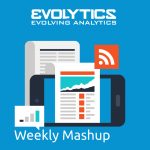
The Weekly Blog is curated content from the Evolytics staff, bringing you the most interesting news in data and analysis from around the web. The Evolytics staff has proven experience and expertise in analytics strategy, tagging implementation, data engineering, and data visualization.
ASK A QUESTION, GET AN ANSWER IN GOOGLE ANALYTICS
GOOGLE ANALYTICS BLOG | BLOG
Google Analytics is going to benefit from the same natural language processing technology as your Android phone. Marketers will simply be able to ask questions such as “how many new users did we gain from the August PPC campaign” and receive an answer from Google.
This innovation comes from the Forrester finding that 57 percent of marketers find it difficult to deliver insights and data access to cross-functional stakeholders, making it a time-consuming effort to communicate basic analytics data to others within the organization.
Evolytics is excited about the evolution of Google Analytics, especially since it will make analytics more accessible to non-analysts. However, the premise of communicating key performance indicators and delivering insights across an enterprise is nothing new. Our award-winning data visualization team specializes in increasing speed to insight and making data more accessible to all stakeholders.
A REFRESHER ON A/B TESTING
HBR | ARTICLE
A/B Testing has formally been in practice since the 1920s when statistician and biologist Ronald Fisher began using it to conduct agricultural experiments. In the 1960s, marketers began applying the concept to evaluate direct response campaigns. While business needs have evolved, our application of statistics remains the same. We’re essentially using the same core concepts, but applying them online in real-time environments.
Kaiser Fung, founder of the applied analytics program at Columbia University, argues there are three major mistakes companies make in their testing programs.
- Due to the ability to monitor real-time results, managers lose patience and fail to allow tests to run their course. While it can be tempting to roll out a positive experience, or turn off a negative one early, due to randomization, it’s possible to see different results if you were to allow your test to run its course.
- Looking at too many metrics. By trying to look at how everything is changing due to a test, you’re setting yourself up to find spurious correlations and lose sight of the overall goal of the test.
- Failing to retest. It can be tempting to accept statistically significant results as gospel, especially if it reiterates your intuition, but all tests have a degree of error, and the mindsets of consumers are rapidly changing. Major changes should continue to be tested, and even back-tested to avoid the rollout of a false positive.
The testing and optimization team at Evolytics works both with new optimization teams, creating best practices to avoid common pitfalls, and with experienced testing teams, applying statistical modeling that leads to additional insights and hypothesis iterations.
THE DATA FOUNDATION FOR AI AND MACHINE LEARNING: 4 INITIATIVES TO GET STARTED
TEALIUM | BLOG
You may already recognize the potential for artificial intelligence (AI) or machine learning in isolated capacities, but there’s a lot of potential in the future, and you should be laying the foundation now.
- Good data collection is the foundation of any strong analytics program. Avoid the temptation to look at what data is available and plan your analytics around it. Instead, think through the customer experience and identify what data should be collected at every step of the way in order to understand and optimize the customer experience. This technique will help you find gaps and create a more comprehensive data set.
- Aggregate your clean data. “This is difficult because the number of technologies organizations are using continues to climb,” the blog states. “Often, the data collected by various systems overlaps or doesn’t speak the same ‘language,’ making integration difficult and time consuming.” Work with a data engineering team such as the one at Evolytics to ease the data standardization and aggregation process, making it simpler to access.
- Connect data to systems in your stack to allow for real-time actions. The ability to analyze data and create a personalized action-based experience will be an important differentiator. Evolytics has partnerships with vendors such as Tealium and Ensighten to make this process easier.
- Map both the data flow and customer flow. By mapping the customer flow and understanding both the limitations and the potential within the associated data, you can optimize experiences and avoid silos.
By adopting these best practices now, you will not only see an immediate return-on-investment, but you will be ready to evolve analytics as AI and machine learning capabilities become more and more accessible as enterprise solutions.
